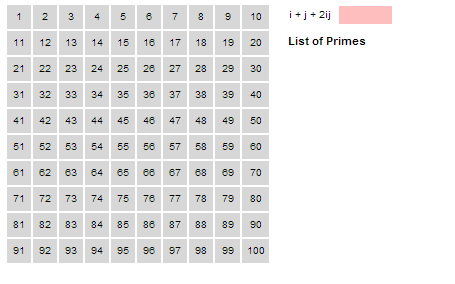Sieve of Sundaram
In mathematics, the sieve of Sundaram is a simple deterministic algorithm for finding all prime numbers up to a specified integer. It was discovered by Indian mathematician S. P. Sundaram in 1934.[1][2]
Algorithm

Start with a list of the integers from 1 to n. From this list, remove all numbers of the form i + j + 2ij where:
The remaining numbers are doubled and incremented by one, giving a list of the odd prime numbers (i.e., all primes except 2) below 2n + 2.
The sieve of Sundaram sieves out the composite numbers just as sieve of Eratosthenes does, but even numbers are not considered; the work of "crossing out" the multiples of 2 is done by the final double-and-increment step. Whenever Eratosthenes' method would cross out k different multiples of a prime , Sundaram's method crosses out for .
Correctness
If we start with integers from 1 to n, the final list contains only odd integers from 3 to . From this final list, some odd integers have been excluded; we must show these are precisely the composite odd integers less than .
Let q be an odd integer of the form . Then, q is excluded if and only if k is of the form , that is . Then we have:
So, an odd integer is excluded from the final list if and only if it has a factorization of the form — which is to say, if it has a non-trivial odd factor. Therefore the list must be composed of exactly the set of odd prime numbers less than or equal to .
See also
References
- ↑ V. Ramaswami Aiyar (1934). "Sundaram's Sieve for Prime Numbers". The Mathematics Student. 2 (2): 73. ISSN 0025-5742.
- ↑ G. (1941). "Curiosa 81. A New Sieve for Prime Numbers". Scripta Mathematica. 8 (3): 164.
- Ogilvy, C. Stanley; John T. Anderson (1988). Excursions in Number Theory. Dover Publications, 1988 (reprint from Oxford University Press, 1966). pp. 98–100, 158. ISBN 0-486-25778-9.
- Honsberger, Ross (1970). Ingenuity in Mathematics. New Mathematical Library #23. Mathematical Association of America. p. 75. ISBN 0-394-70923-3.
- A new "sieve" for primes, an excerpt from Kordemski, Boris A. (1974). Köpfchen, Köpfchen! Mathematik zur Unterhaltung. MSB Nr. 78. Urania Verlag. p. 200. (translation of Russian book Кордемский, Борис Анастасьевич (1958). Математическая смекалка. М.: ГИФМЛ.)
- Movshovitz-Hadar, N. (1988). "Stimulating Presentations of Theorems Followed by Responsive Proofs". For the Learning of Mathematics. 8 (2): 12–19.
- Ferrando, Elisabetta (2005). "Abductive processes in conjecturing and proving" (PDF). Ph.D. theses. Purdue University. pp. 70–72.
- Baxter, Andrew. "Sundaram's Sieve". Topics from the History of Cryptography. MU Department of Mathematics. External link in
|journal=(help)